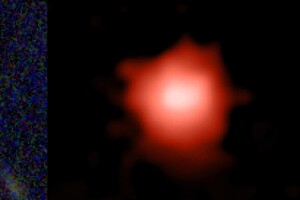The galaxy is 13.5 billion light years from Earth.

A week after the publication of the first pictures taken < strong>telescope “James Webb”, it became known about a new discovery made by the device. It may have found a galaxy 13.5 billion light-years from Earth, Science Alert reports.
Known as GLASS-z13, the galaxy appeared only 300 million years after the Big Bang . It is 100 million years older than any other such object known at the moment.
Read also: James Webb Space Telescope's first color photo of the early universe – NASA astrophysics.
The farther the object is from us, the longer it takes light to reach us. This means that by looking into the distant universe, we can look into the distant past.
Although GLASS-z13 formed early in the universe, its exact age cannot be determined. It could have appeared at any moment in the first 300 million years after the Big Bang.
The galaxy was discovered in so-called early data releases from James Webb's primary thermal imager, called NIRcam, but the discovery was not revealed in the first set images released by NASA last week. When converted from infrared to visible light, the galaxy looks like a red spot with a white center.
Naidu and 25 other astronomers from around the world submitted their findings to a scientific journal. So far, the study has been posted on the preprints website, meaning it has not been peer-reviewed. But it has already caused a stir in the world community of astronomers.
According to Naidu, another group of scientists who worked with this data set obtained similar results.
Remember, the development of the telescope began back in 1996. year It was originally planned to launch in 2007, but the mission faced a series of postponements and delays. Because of this, the budget of the project has increased, at the moment it is estimated at 9.7 billion dollars, 861 million of which will be sent to support it during the first five years after launch.
“James Webb” will be engaged in the study of galaxies the early universe, the study of the formation of new stars and the observation of the planets of the solar system.
The launch of the telescope was postponed several times last year as well. Yes, it was planned to be launched on December 18, then the launch was postponed to December 22, and later to December 24. The launch took place on December 25.




